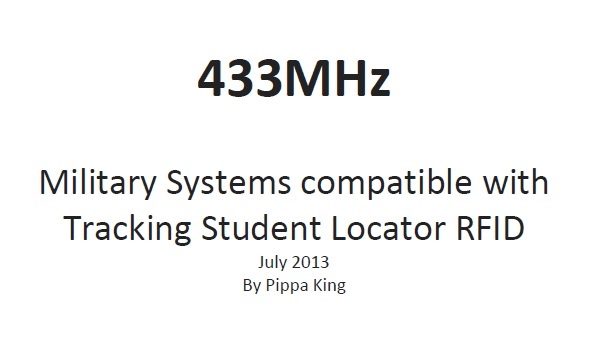433MHz is the most used frequency on earth and is also the radio frequency used in John Jay High School, Texas, USA to track students on their premises. The RFID tags worn emit a pulsed constant frequency and cannot be turned off by the students so effectively broadcast the student/tags whereabouts 24-7. The tag works as an antenna and sensors around the school pick up the RFID (antenna) frequencies – this is an active RFID tag. In fact sensors anywhere can pick up a tag’s radio frequencies.
433Mhz is ex-military – Savi, a company owned by Lockheed Martin, developed the 433MHz RFID technology (ISO18000-7 ratified in 2006) and have supplied homeland-security and port-related RFID security to the US military during the past decade. According to the RFID Journal, “Savi RFID tags track assets in shipments throughout the world. Its customers include the U.S. government, as well as NATO and other civil and defense agencies”. Savi “has been the primary provider of active RFID solutions for the Department Of Defense, particularly in the agency’s In-Transit Visibility network, which monitors the movements of containers and products through the supply chain by means of 433 MHz active RFID tags, readers and software.” and according to Mark Lieberman, the Automatic-Identification Technology (AIT) Program Manager at the Defense Logistics Agency (DLA), “There was a time when Savi was the sole supplier of tags and infrastructure end items to DOD [Department of Defense].”
In January 2009 the US Department of Defense announced a $429 million RFID contract for DASH7 (ISO18000-7) devices, which was awarded to several companies. From DASH7 Alliance wiki “It was agreed that current self-certification of interoperability was insufficient [between the companies awarded the contract] and that a more formalized process for determining conformance with the ISO 18000-7 standard and interoperability across vendors was needed” – so Savi initialized the first meeting of DASH7 members in February 2009. The DASH7 Alliance now has over 50 members including 7 universities and “offers such interoperability to standards bodies, Industry associations and related government entities in order to accelerate adoption and advance integration for the benefit of society.” Benefiting society, of course… this technology did not benefit Andrea Hernandez when she chose not to use it and be tracked by a 433 RFID tag in school. 433MHz occupies the ISM (Industrial, Scientific and Medical) radio band, reserved internationally generally for unlicensed use, therefore free to use. With this, 433 frequency now finds itself firmly embedded in public domestic society.
Is it wrong to say 433MHz is ex-military? ‘Ex’ implying no longer used. It is probably more accurate to say 433 is from the military. There are presumably military sensors all around the US for their In-Transit Visibility Network and the same frequency is used increasingly for schools student location, credit cards, agricultural, biomedical, door (garage) openers and wireless alarm systems to name a few.
The features of 433MHz can be up to “range of up to 2 km, indoor location with 1 meter accuracy,”. Whether or not key fobs and student locator RFID have this 2 km range or that student RFID tags are being tracked by government sensors across the country, we need to bear in mind that this technology is invisible and a constant, subconscious interaction with wireless technology is happening when we use it.
The age of ubiquitous technologies is upon us.
When we have an item that ‘magically’ interacts with other pieces of technology maybe we need to start asking what it is we carry – and hopefully trust that we are being given the right answer.










